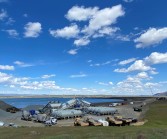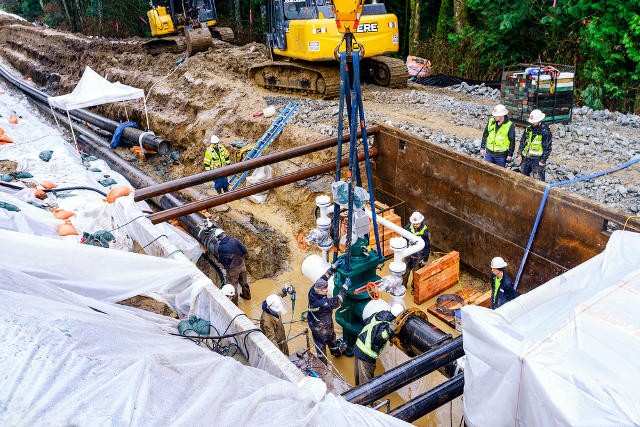PRIEST RAPIDS DAM - The idea of raising fish to replace fish - and not just replace fish, to increase the fish population along the Columbia River - dates back almost to the beginning of development along the river. Some of the lessons of that century-and-a quarter have been cemented into the upgrades at the fish hatchery at Priest Rapids Dam.
The upgrades cost about $16.42 million, said Chuck Allen, public information officer with the Grant County PUD, which operates the dam. The upgrades included a quarter-mile of new rearing ponds, six in all, and a new building for raising fingerlings, called an incubation building. There's also a new fish acclimation pond.
The trap that catches fish for harvest was upgraded, said Todd Pearsons, PUD senior fisheries scientist. The PUD built a new "sorting and processing area," and a new broodstock pond, Pearsons said.
The PUD is required to produce 5.6 million fall Chinook salmon smolts at Priest Rapids each year, Allen said. The facility is run in conjunction with the state Department of Fish and Wildlife.
It's part of a network of hatcheries that extends all the way from the Columbia River Gorge to Penticton, British Columbia. They're operated by varying consortiums of dam-owning PUDs, Native American agencies, and federal and state fish and wildlife agencies.
The last year for which fish return statistics are available is 2007, Pearsons said. For the fish spawned in 2007, the return rate was 25.1, Pearsons said, which means that for each salmon captured and spawned in 2007, 25 of its descendants have returned to the hatchery.
Success depends on a lot of things outside human control, like ocean conditions and predation, Pearsons said, and not every year is as good. To increase the odds, the remodeled hatchery tries to use the lessons learned in 125 years of fish management.
"We went through a big long hatchery reform process," Pearsons said. Among the lessons learned was that fish know the waters where they were spawned. Previous practice assumed that a fish raised in one hatchery could be acclimated and released anywhere along the river, Pearsons said. Now there's more attention to raising fish in the spot where fish managers want them to return, he said.
The adult salmon are captured in a channel not far from the river, and swim up the channel to a cement trap. They are transferred to a truck and driven about a quarter-mile to the hatchery.
The fish are transferred into a holding pond, where they get an electric shock that calms them down. From there, hatchery employees route some into the broodstock pond; their eggs and sperm are harvested to produce the next generation. The rest, Pearsons said, are donated to food banks along the mid-Columbia.
The salmon are subject to elaborate marking and tracking procedures to ensure most of the harvest is hatchery fish. Parsons estimated about 98 percent of the fish harvested at Priest Rapids are hatchery fish.




